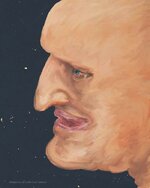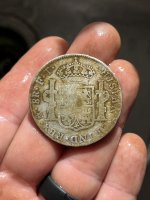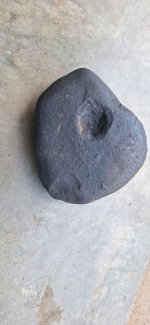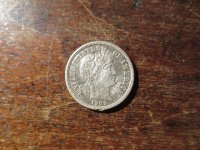DeepseekerADS
Gold Member
- Mar 3, 2013
- 14,880
- 21,725
- Detector(s) used
- CTX, Excal II, EQ800, Fisher 1260X, Tesoro Royal Sabre, Tejon, Garrett ADSIII, Carrot, Stealth 920iX, Keene A52
- Primary Interest:
- Other
Faces of the men who won America's independence
This is so neat, and one heck of a way to close out the Independence weekend!
Amazing early photos of heroes of the Revolutionary War in their old age
Faces of the American revolution: Amazing early photographs which document some of the heroes of the War for Independence in their later years | Mail Online
These stunning images are early photographs of some of the men who bravely fought for their country in the Revolutionary War some 237 years ago.
Images of Americans who fought in the Revolution are exceptionally rare because few of the Patriots of 1775-1783 lived until the dawn of practical photography in the early 1840s.
These early photographs – known as daguerreotypes – are exceptionally rare camera-original, fully-identified photographs of veterans of the War for Independence – the war that established the United States.
The majority have been compiled by Utah-based journalist Joe Baumam, who spent three decades researching and compiling the images. Digging through a myriad of sources - 18th and 19th century battle accounts, muster rolls, genealogical records, pension files, letters, period newspapers, town and county histories - he was able to flesh out the stories of these veterans.
Bauman found and bought eight daguerreotypes, plus five paper prints from the era - considered the largest known collection of Revolutionary War veteran daguerreotypes to date.
The men included a shoemaker, two ministers, a doctor who later managed a vast mercantile empire, a tavern-keeper, a settler of the Ohio frontier, a blacksmith and the captain of a coastal vessel.
They suffered, starved and fought through the Revolution, and their experiences are thrilling - from watching the beginning of the Boston Tea Party, to undergoing capture as a prisoner of war, to fighting in the Monmouth, Quaker Hill, Charleston, Bennington and Yorktown battles, to witnessing the final British surrender. As amazing as their stories are, the daguerreotype portraits are even more transfixing. Several years ago, Bauman published the images, along with histories of the men, in an e-book, Don’t Tread on Me: Photographs and Life Stories of American Revolutionaries.
‘It gives you a sort of a direct contact with a person who lived that very long time ago, and experienced these almost mythological-type days,’ he told TIME. The inspiration for his epic search was a much earlier collection of daguerreotypes compiled by the Reverend E. B. Hillard, author of The Last Men of the Revolution. In July 1864, Hillard, accompanied by two photographers, brothers N. A. and R. A. Moore, traveled across New England and New York State to interview and photograph all known surviving veterans - they found six in total. Five of those images now belong to Bauman who has overseen a reprint of Hillard's original book.
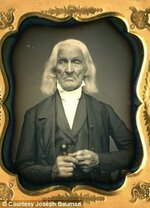
JONATHAN SMITH
Fought in the Battle of Long Island on August 29, 1778. His unit was the first brigade that went out on Long Island, and was discharged in December after a violent snow storm. After the war he became a Baptist minister. He was married three times and had eleven children. On October 20, 1854, he had a daguerreotype taken to give to a granddaughter. He died on January 3, 1855.
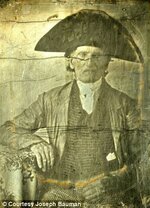
GEORGE FISHLEY
A soldier in the Continental army. When the British army evacuated Philadelphia and raced toward New York City, his unit participated in the Battle of Monmouth. He was part the genocidal attack on Indians who had sided with the British, a march led by General John Sullivan through 'Indian country,' parts of New York and Pennsylvania. Fishley was a famous character after the war in Portsmouth, New Hampshire, where he lived and was known as 'the last of our cocked hats.'
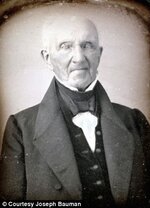
JAMES HEAD
Joined the Continental Navy at age 13 and served as a midshipman aboard the frigate Queen of France. Taken as a prisoner of war, Head was released at Providence, Rhode Island and walked home. His brother wrote that when he arrived, Head was deaf in one ear and had hearing loss in the other from the cannons’ concussion. Settling in a remote section of Massachusetts that later became Maine, he was elected a delegate to the Massachusetts convention in Boston that was called to ratify the Constitution. When he died he was the richest man in Warren, Maine and stone deaf because of his war injuries.
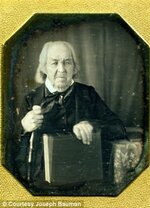
REV. LEVI HAYES
A fifer in a Connecticut regiment that raced toward West Point to protect it from an impending attack. He also participated in a skirmish with enemy 'Cow Boys' at the border of a lawless region called the Neutral Ground (most of Westchester County, New York, and the southwestern corner of Connecticut). In the early years of the nineteenth century, he helped organize a religiously-oriented land company that headed into the wilderness of what was then the West. They settled Granville, Ohio, where he was the township treasurer and a deacon of his church.
His daguerreotype shows him holding a large book, most likely a Bible.
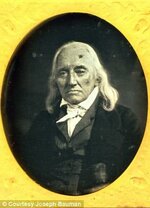
PETER MACKINTOSH
He was a 16-year-old apprentice blacksmith in Boston working on the night of December 16, 1773 when a group of young men rushed into the shop, grabbed ashes from the hearth and rubbed them on their faces. They were among those running to Griffin’s Wharf to throw tea into the harbor as part of the Boston Tea Party that started the Revolution. Mackintosh later served in the Continental Artillery as an artificer, a craftsman attached to the army who shoed horses and repaired cannons.
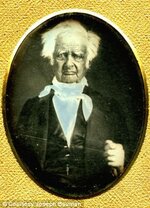
SIMEON HICKS
A Minuteman from Rehoboth, Massachusetts. Hicks mobilised with his unit and helped seal off a British garrison in Boston after the Battles of Lexington and Concorde. He served several short enlistments and fought in the Battle of Bennington, August 16, 1777. After the war Hicks became something of a local celebrity and lived out his final years in in Sunderland, Vermont. He was the last person alive to have seen the Battle of Bennington.
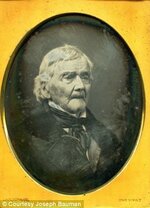
DANIEL SPENCER
A member of the elite Sheldon’s Dragoons. He sat up all night fanning his commanding officer, Captain George Hurlbut, who had been shot in a fight during which the British captured a supply ship. Spencer’s account of the death of the officer differed markedly from that of Gen. Washington's; Spencer said the wounds of the officer had nearly healed when he caught a disease from a prostitute and this illness killed him, whereas Washington said he died of his wounds. Spencer’s pension was revoked soon after it was granted and for years he and his family lived in severe poverty. Eventually his pension was restored. He was the guest of honor during New York City’s celebration of July 4, 1853.
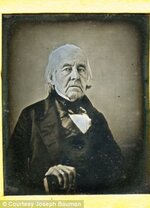
DR. ENEAS MUNSON
As a teenager, he helped care for the wounded in his hometown of New Haven, Connecticut, after the British invaded. Commissioned as a surgeon’s mate when he was 16 years old, shortly before he graduated from Yale. He extracted bullets from soldiers during battle. In 1781 he was part of Gen. Washington’s great sweep to Yorktown, Virginia, which led to Gen. Cornwallis’ surrender and American victory of the Revolution. During the fighting at Yorktown he was an eyewitness to actions of Gen. Washington, Gen. Knox, and Col. Alexander Hamilton. Gave up medicine after the war and became a wealthy businessman, but his family spoke of how he loved recalling the exciting days of the war, when he was a teenage officer.
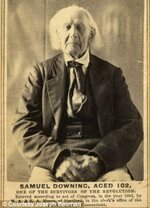
SAMUEL DOWNING
Enlisted at age 16, and served as a private from New Hampshire. At the time his picture was made, he as 102 and living in the town of Edinburgh, Saratoga Country, New York. He died on February 18, 1867.
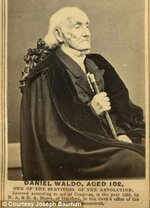
REV. DANIEL WALDO
Drafted in 1778 for a month of service in New London. After that, he enlisted for an additional eight months, and in March 1779 was taken prisoner by the British at Horseneck. After his released, returned to his farm again.
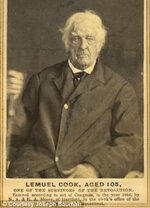
LEMUEL COOK
Witnessed the British surrender at Yorktown, the event that guaranteed American independence. Of the event, he said, 'Washington ordered that there should be no laughing at the British; said it was bad enough to surrender without being insulted. 'The army came out with guns clubbed on their backs. They were paraded on a great smooth lot, and there they stacked their arms.'
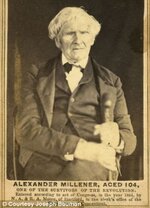
ALEXANDER MILLINER
Enlisted as a drummer boy who served in Gen. Washington’s Life Guard unit. He was a favorite of Washington’s, often playing at his personal request. Was at the British surrender at Yorktown: 'The British soldiers looked down-hearted. When the order came to "ground arms," one of them exclaimed, with an oath, "You are not going to have my gun!" and threw it violently on the ground, and smashed it.'
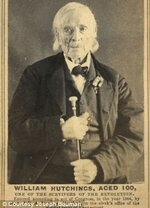
WILLIAM HUTCHINGS
Enlisted at age 15 for the coastal defense of his home state, New York. Writes Hillard in The Last Men of the Revolution, 'The only fighting which he saw was the siege of Castine, where he was taken prisoner; but the British, declaring it a shame to hold as prisoner one so young, promptly released him.'
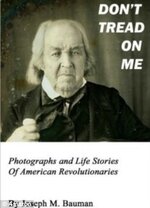
This is so neat, and one heck of a way to close out the Independence weekend!
Amazing early photos of heroes of the Revolutionary War in their old age
Faces of the American revolution: Amazing early photographs which document some of the heroes of the War for Independence in their later years | Mail Online
These stunning images are early photographs of some of the men who bravely fought for their country in the Revolutionary War some 237 years ago.
Images of Americans who fought in the Revolution are exceptionally rare because few of the Patriots of 1775-1783 lived until the dawn of practical photography in the early 1840s.
These early photographs – known as daguerreotypes – are exceptionally rare camera-original, fully-identified photographs of veterans of the War for Independence – the war that established the United States.
The majority have been compiled by Utah-based journalist Joe Baumam, who spent three decades researching and compiling the images. Digging through a myriad of sources - 18th and 19th century battle accounts, muster rolls, genealogical records, pension files, letters, period newspapers, town and county histories - he was able to flesh out the stories of these veterans.
Bauman found and bought eight daguerreotypes, plus five paper prints from the era - considered the largest known collection of Revolutionary War veteran daguerreotypes to date.
The men included a shoemaker, two ministers, a doctor who later managed a vast mercantile empire, a tavern-keeper, a settler of the Ohio frontier, a blacksmith and the captain of a coastal vessel.
They suffered, starved and fought through the Revolution, and their experiences are thrilling - from watching the beginning of the Boston Tea Party, to undergoing capture as a prisoner of war, to fighting in the Monmouth, Quaker Hill, Charleston, Bennington and Yorktown battles, to witnessing the final British surrender. As amazing as their stories are, the daguerreotype portraits are even more transfixing. Several years ago, Bauman published the images, along with histories of the men, in an e-book, Don’t Tread on Me: Photographs and Life Stories of American Revolutionaries.
‘It gives you a sort of a direct contact with a person who lived that very long time ago, and experienced these almost mythological-type days,’ he told TIME. The inspiration for his epic search was a much earlier collection of daguerreotypes compiled by the Reverend E. B. Hillard, author of The Last Men of the Revolution. In July 1864, Hillard, accompanied by two photographers, brothers N. A. and R. A. Moore, traveled across New England and New York State to interview and photograph all known surviving veterans - they found six in total. Five of those images now belong to Bauman who has overseen a reprint of Hillard's original book.

JONATHAN SMITH
Fought in the Battle of Long Island on August 29, 1778. His unit was the first brigade that went out on Long Island, and was discharged in December after a violent snow storm. After the war he became a Baptist minister. He was married three times and had eleven children. On October 20, 1854, he had a daguerreotype taken to give to a granddaughter. He died on January 3, 1855.

GEORGE FISHLEY
A soldier in the Continental army. When the British army evacuated Philadelphia and raced toward New York City, his unit participated in the Battle of Monmouth. He was part the genocidal attack on Indians who had sided with the British, a march led by General John Sullivan through 'Indian country,' parts of New York and Pennsylvania. Fishley was a famous character after the war in Portsmouth, New Hampshire, where he lived and was known as 'the last of our cocked hats.'

JAMES HEAD
Joined the Continental Navy at age 13 and served as a midshipman aboard the frigate Queen of France. Taken as a prisoner of war, Head was released at Providence, Rhode Island and walked home. His brother wrote that when he arrived, Head was deaf in one ear and had hearing loss in the other from the cannons’ concussion. Settling in a remote section of Massachusetts that later became Maine, he was elected a delegate to the Massachusetts convention in Boston that was called to ratify the Constitution. When he died he was the richest man in Warren, Maine and stone deaf because of his war injuries.

REV. LEVI HAYES
A fifer in a Connecticut regiment that raced toward West Point to protect it from an impending attack. He also participated in a skirmish with enemy 'Cow Boys' at the border of a lawless region called the Neutral Ground (most of Westchester County, New York, and the southwestern corner of Connecticut). In the early years of the nineteenth century, he helped organize a religiously-oriented land company that headed into the wilderness of what was then the West. They settled Granville, Ohio, where he was the township treasurer and a deacon of his church.
His daguerreotype shows him holding a large book, most likely a Bible.

PETER MACKINTOSH
He was a 16-year-old apprentice blacksmith in Boston working on the night of December 16, 1773 when a group of young men rushed into the shop, grabbed ashes from the hearth and rubbed them on their faces. They were among those running to Griffin’s Wharf to throw tea into the harbor as part of the Boston Tea Party that started the Revolution. Mackintosh later served in the Continental Artillery as an artificer, a craftsman attached to the army who shoed horses and repaired cannons.

SIMEON HICKS
A Minuteman from Rehoboth, Massachusetts. Hicks mobilised with his unit and helped seal off a British garrison in Boston after the Battles of Lexington and Concorde. He served several short enlistments and fought in the Battle of Bennington, August 16, 1777. After the war Hicks became something of a local celebrity and lived out his final years in in Sunderland, Vermont. He was the last person alive to have seen the Battle of Bennington.

DANIEL SPENCER
A member of the elite Sheldon’s Dragoons. He sat up all night fanning his commanding officer, Captain George Hurlbut, who had been shot in a fight during which the British captured a supply ship. Spencer’s account of the death of the officer differed markedly from that of Gen. Washington's; Spencer said the wounds of the officer had nearly healed when he caught a disease from a prostitute and this illness killed him, whereas Washington said he died of his wounds. Spencer’s pension was revoked soon after it was granted and for years he and his family lived in severe poverty. Eventually his pension was restored. He was the guest of honor during New York City’s celebration of July 4, 1853.

DR. ENEAS MUNSON
As a teenager, he helped care for the wounded in his hometown of New Haven, Connecticut, after the British invaded. Commissioned as a surgeon’s mate when he was 16 years old, shortly before he graduated from Yale. He extracted bullets from soldiers during battle. In 1781 he was part of Gen. Washington’s great sweep to Yorktown, Virginia, which led to Gen. Cornwallis’ surrender and American victory of the Revolution. During the fighting at Yorktown he was an eyewitness to actions of Gen. Washington, Gen. Knox, and Col. Alexander Hamilton. Gave up medicine after the war and became a wealthy businessman, but his family spoke of how he loved recalling the exciting days of the war, when he was a teenage officer.

SAMUEL DOWNING
Enlisted at age 16, and served as a private from New Hampshire. At the time his picture was made, he as 102 and living in the town of Edinburgh, Saratoga Country, New York. He died on February 18, 1867.

REV. DANIEL WALDO
Drafted in 1778 for a month of service in New London. After that, he enlisted for an additional eight months, and in March 1779 was taken prisoner by the British at Horseneck. After his released, returned to his farm again.

LEMUEL COOK
Witnessed the British surrender at Yorktown, the event that guaranteed American independence. Of the event, he said, 'Washington ordered that there should be no laughing at the British; said it was bad enough to surrender without being insulted. 'The army came out with guns clubbed on their backs. They were paraded on a great smooth lot, and there they stacked their arms.'

ALEXANDER MILLINER
Enlisted as a drummer boy who served in Gen. Washington’s Life Guard unit. He was a favorite of Washington’s, often playing at his personal request. Was at the British surrender at Yorktown: 'The British soldiers looked down-hearted. When the order came to "ground arms," one of them exclaimed, with an oath, "You are not going to have my gun!" and threw it violently on the ground, and smashed it.'

WILLIAM HUTCHINGS
Enlisted at age 15 for the coastal defense of his home state, New York. Writes Hillard in The Last Men of the Revolution, 'The only fighting which he saw was the siege of Castine, where he was taken prisoner; but the British, declaring it a shame to hold as prisoner one so young, promptly released him.'



